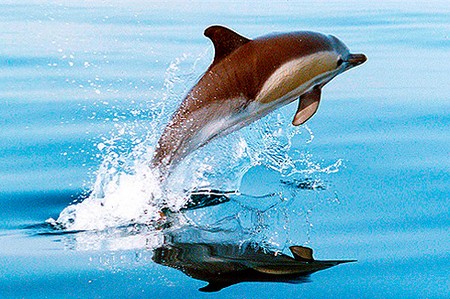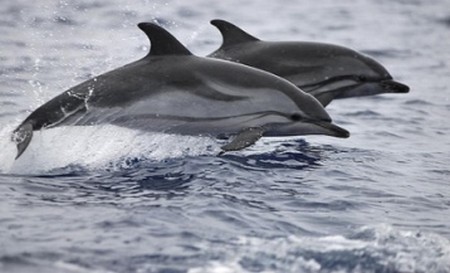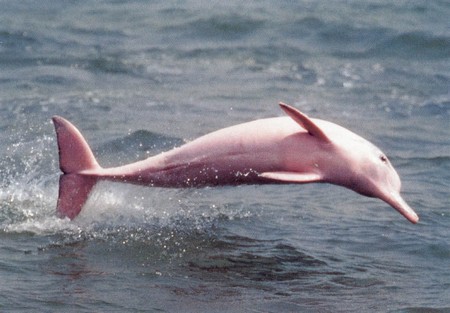Closely related to whales and porpoises, dolphins are the marine mammals with over forty species in the group of seventeen. Dolphins are magnificent creatures with a beauty and innocence. Unfortunately, due to the brutality of the humans, this creature has nearly driven to the edge of extinction. Dolphins are considered as the fastest, most intelligent and most beautiful creature, but the uncontrollable greed of the humans has forced this innocent creature to its doom. For dolphin lovers, this fact might make them despise the brutality of humans. We have plenty of evidences from history where dolphins saved the shipwreck sailors and many other creatures. Still, many people have reported the examples of dolphins circling around swimmers to prevent sharks. Dolphins are perhaps the best marine friend of the humans and humans are not respecting the worth of this friend. In the following lines we will throw brief light on the different types of dolphin found in the world of water.
Types of Dolphins in the World
Most of the people are not aware of this fact that there are different species of dolphins available across the world, including 32 types of oceanic dolphins, 5 types of river dolphins and 6 types of porpoises. Let us have a look at them:
Oceanic Dolphins
White Beaked Dolphin: These dolphins have a plump looking body with a blackish or gray hide. They can grow up to 3 meters, having a gray to dark grey beaks with white belly. Due to this feature, they are named as white beaked dolphins. They have a unique ‘rooster tail splash’ while swimming and are very acrobatic.
Striped Dolphin: As the name suggest, these dolphins have stripes on their skin running from their beak to all the way around their eyes and down to the rear sides. Striped dolphins are impressive leapers and can jump up to the height of 7 meters. Hide color in these dolphins varies from one type of dolphin to another. It usually ranges from gray to brown and slight darker in shade as compared to normal dolphin.
Black Dolphin: Black dolphins are small species that grow up to 1.4 meter. They are slight darker in color than the common dolphins. They are white in color on throat and belly region. When noticed underwater, they appear to be tan brown in color with a white spot behind the flipper and a dark line running along the body. Unlike other species of dolphins, the amount of research conducted on these dolphins is very less.
Heaviside’s Dolphin: Heaviside’s dolphins are found in the waters of Atlantic coasts of Southern Africa. It is not as popular as other species of dolphins. It has head slightly conical and irregular dorsal fins. Head and thorax bears the gray color, whereas dorsal side has bluish-black color. Though, similar to killer whales in appearance, they have distinctive habits and size.
Melon-Headed Dolphin: Bearing slightly gray color with a dark gray face, these dolphins are quick swimmer making short leaps off the sea surface. Due to their dark gray face, it is often called as the ‘mask’. They bear a round-shaped head but not as round as the pygmy killer dolphin. Due to their round-shaped head, they are often called as the ‘melon-headed dolphin’.
Bottlenose Dolphins
Bottlenose dolphins, the genus Tursiops are common and popular members of the Delphinidae family (family of oceanic dolphins). Genus is categorized into two species, i.e. the common bottlenose dolphin (Tursiops truncatus) and the Indo-Pacific bottlenose dolphin (Tursiops aduncus), according to the molecular studies. Bottlenose dolphins live in groups of 20-30 members. They are found in warm and temperate seas.
The other types of dolphins are as follows:
- Dusky dolphin
- Risso’s dolphin
- Hector’s dolphin
- Long-snouted spinner dolphin
- Peale’s dolphin
- Clymene dolphin
- Long-beaked common dolphin
- Short-beaked common dolphin
- Commerson’s dolphin
- Hourglass dolphin
- Pantropical dolphin
- Frasier’s dolphin
- Irrawaddy dolphin
- Rough-toothed dolphin
- Atlantic spotted dolphin
- Atlantic humpback dolphin
- Atlantic white-sided dolphin
- Pacific white-sided dolphin
- Indo-Pacific humpback dolphin
- Southern right whale dolphin
- Northern right whale dolphin
- Pygmy killer whale
- False killer whale
- Orcas (killer whale)
- Long-finned pilot whale
- Short finned pilot whale
River Dolphins
The species found in the estuaries and freshwater rivers are four in number. The four species of river dolphins are:
- Yangtze or Baiji River Dolphin
- Boto or Amazon River Dolphin
- Ganges or Indus River Dolphin
- La Plata Dolphin
The first three species mentioned in the list above live in the freshwater rivers, where as the fourth species, La Plata dolphin inhabits in the salt-water estuaries. From a scientific standpoint, this species is ranked with the river dolphin variety instead of the oceanic type. River dolphins don’t have much resemblance with oceanic cousins. River dolphins have larger beaks that form the one-fifth of the total body length, well developed brains and short, broad flippers. As these dolphins live in muddy waters, they are nearly blind.
Porpoises
Porpoise is a small whale that often categorized as a species of dolphin. However, porpoises are quite different from the common dolphins. These are smaller in size and are given the name of small dolphins from sailors and fishermen. Porpoises bear a short and blunt snout and known to be shy mammals which is the major reason that they are rarely noticed. Normally, porpoises are divided into six major types which are:
- Burmeister’s Porpoise
- Finless Porpoise
- Harbor Porpoise
- Vaquita Porpoise
- Spectacled Porpoise
- Dall’s Porpoise
These were the major types of dolphins living across the world. Some of these species are endangered for several reasons and the major among all is the greed of humans. The species which are at great risk of becoming extinct include The Indo-Pacific hump-back dolphin, the Amazon river or pink dolphin, the Indus river dolphin and the Yangtze or Baiji river dolphin. The major causes that are endangering the existence of dolphins along with other marine creatures involve the increased river traffic, river contamination, destruction of tropical rainforests, dam constructions and so on.
It is the responsibility of each and every individual to make collective efforts to save this beautiful, endearing creature. However, some organizations and volunteer programs have dedicated themselves to the noble cause of saving this creature.



